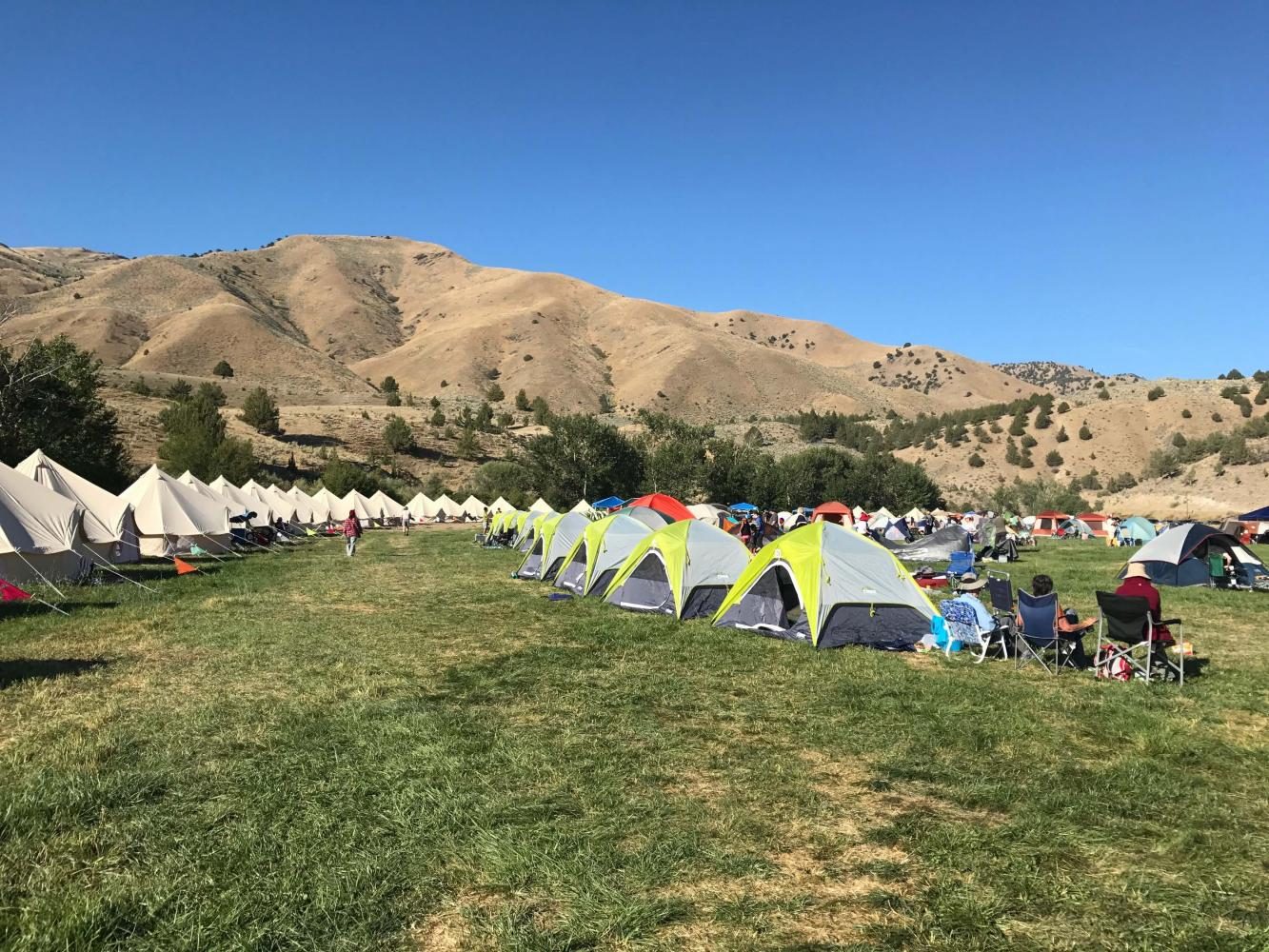Solar eclipse sweeps across America
Eclipse tents at an eclipse event in Oregon. Residents and visitors allike gathered to see a total eclipse.
September 7, 2017
Two minutes of awe were all that observers were hoping for when they tuned in to the skies on Aug. 21 to witness the Great American Eclipse, the first total solar eclipse visible in the contiguous United States since 1979.
Individuals within the eclipse’s path of totality, defined as the shadow of the moon cast upon the surface of the Earth during a solar eclipse, were able to observe a total eclipse that day. The path of totality for this year’s eclipse stretched from the northwestern to the southeastern United States, with the first instance of totality in Oregon beginning at around 10:17 a.m. PST and the last in South Carolina beginning at around 11:42 a.m. PST.

The eclipse, as viewed from California. California was not in its path of totality.
Observatories and museums nationwide hosted viewing parties for this year’s total solar eclipse. In the Bay Area, Oakland’s Chabot Space and Science Center, Mountain View’s NASA Ames Research Center and San Francisco’s California Academy of Sciences were some of the venues that invited the public to watch the eclipse. Many organizations also offered and distributed eclipse glasses locally in efforts to promote safe eclipse viewing practices and to educate skywatchers about the dangers of looking directly at the sun.
“Regular sunglasses, depending on the pair of sunglasses and whether they’re polarized or not, only block around 20 to 80 percent of the light that’s going through them. Eclipse glasses are made for eclipses and block about 99.9999 percent of that light,” Dr. Cameron Hummels, California Institute of Technology postdoctoral scholar in astronomy, said. “The sun is extremely hot—about five to six thousand degrees Kelvin—and it’s pumping out lots and lots of photons. Those photons can very quickly overwhelm the retina in your eye and start to do damage.”
A solar eclipse occurs when the moon either partially or fully obscures the sun and its light while passing between the Earth and the sun. Although solar eclipses only happen during new moon and the moon falls into its new moon phase around once every 29.5 days, the unique elliptical shape of the moon’s orbit around the Earth, among other factors, prevents us from being able to witness a solar eclipse every month.
“The orbit of the moon is tilted to the plane of the Earth’s orbit around the sun. As a result, most of the time the moon either passes above the sun or below the sun at new moon,” Griffith Observatory astronomical observer Anthony Crook said. “It’s only about roughly once every six months that it crosses the plane of the Earth’s shadow at new or full moon. You can have more than two eclipses a year, but they’re roughly spaced out by six months.”
Eclipse season designates the period of time during which the moon and the sun are both at either of two lunar nodes, or points where the moon’s orbit around the Earth meets the Earth’s orbit around the sun. The position of the moon, Earth and sun during a solar eclipse is an example of a syzygy, the phenomenon of three celestial bodies in alignment.
Solar eclipses can happen anytime between two to five times a year, and a total solar eclipse is visible from Earth around once every 18 months, or around twice every three years. NASA predicts that on average, a total solar eclipse at any specified location on Earth occurs only once every 375 years.
“The Earth is rotating once a day on its axis, and often one is on the wrong side of the Earth to see the moon eclipse the sun—for example, no one in Europe, Asia or Africa [saw] this eclipse,” Columbia professor of astronomy Dr. David Helfand said. “The shadow of a total eclipse is only a few miles to maybe 100 miles wide, so any given place rarely gets the full shadow.”
The last total solar eclipse visible from the contiguous United States occurred on Feb. 26, 1979, following a path of totality that stretched across the northwestern to the central United States. On July 11, 1991, a total solar eclipse crossed over Hawaii.
For those who missed the Great American Eclipse, the next total solar eclipse will be visible to observers in Mexico and South America on July 2, 2018. The next total solar eclipse visible to observers in the United States will occur on April 8, 2024, following a path of totality from the southern to the northeastern regions.
This piece was originally published in the pages of the Winged Post on September 6, 2017.


















![“[Building nerf blasters] became this outlet of creativity for me that hasn't been matched by anything else. The process [of] making a build complete to your desire is such a painstakingly difficult process, but I've had to learn from [the skills needed from] soldering to proper painting. There's so many different options for everything, if you think about it, it exists. The best part is [that] if it doesn't exist, you can build it yourself," Ishaan Parate said.](https://harkeraquila.com/wp-content/uploads/2022/08/DSC_8149-900x604.jpg)




![“When I came into high school, I was ready to be a follower. But DECA was a game changer for me. It helped me overcome my fear of public speaking, and it's played such a major role in who I've become today. To be able to successfully lead a chapter of 150 students, an officer team and be one of the upperclassmen I once really admired is something I'm [really] proud of,” Anvitha Tummala ('21) said.](https://harkeraquila.com/wp-content/uploads/2021/07/Screen-Shot-2021-07-25-at-9.50.05-AM-900x594.png)







![“I think getting up in the morning and having a sense of purpose [is exciting]. I think without a certain amount of drive, life is kind of obsolete and mundane, and I think having that every single day is what makes each day unique and kind of makes life exciting,” Neymika Jain (12) said.](https://harkeraquila.com/wp-content/uploads/2017/06/Screen-Shot-2017-06-03-at-4.54.16-PM.png)








![“My slogan is ‘slow feet, don’t eat, and I’m hungry.’ You need to run fast to get where you are–you aren't going to get those championships if you aren't fast,” Angel Cervantes (12) said. “I want to do well in school on my tests and in track and win championships for my team. I live by that, [and] I can do that anywhere: in the classroom or on the field.”](https://harkeraquila.com/wp-content/uploads/2018/06/DSC5146-900x601.jpg)
![“[Volleyball has] taught me how to fall correctly, and another thing it taught is that you don’t have to be the best at something to be good at it. If you just hit the ball in a smart way, then it still scores points and you’re good at it. You could be a background player and still make a much bigger impact on the team than you would think,” Anya Gert (’20) said.](https://harkeraquila.com/wp-content/uploads/2020/06/AnnaGert_JinTuan_HoHPhotoEdited-600x900.jpeg)

![“I'm not nearly there yet, but [my confidence has] definitely been getting better since I was pretty shy and timid coming into Harker my freshman year. I know that there's a lot of people that are really confident in what they do, and I really admire them. Everyone's so driven and that has really pushed me to kind of try to find my own place in high school and be more confident,” Alyssa Huang (’20) said.](https://harkeraquila.com/wp-content/uploads/2020/06/AlyssaHuang_EmilyChen_HoHPhoto-900x749.jpeg)








